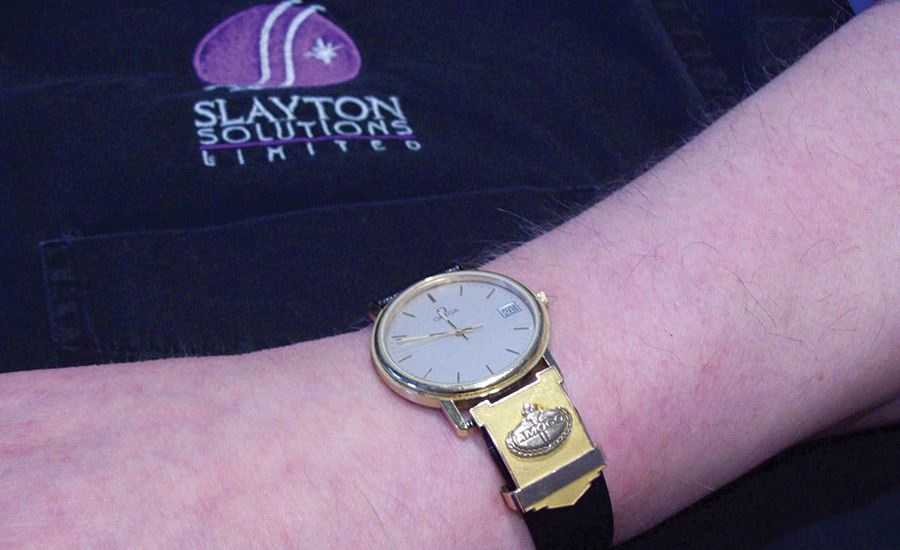“Now the time has come / There are things to realize.” — “Time Has Come Today,” Chambers Bros., 1966
It has been 20 years since my father John left his mortal coil, and I think about him often. He was a successful corporate businessman who steadily rose through the ranks of a major U.S. energy company.
When discussing the business world with me, he always made two points. According to him, the keys to success are a.) Always wear a clean and pressed white shirt, and b.) Always be on time for appointments or when the work day starts. And according to him (and Vince Lombardi) “on time” means fifteen minutes early.
On the subject of the white shirt, my dad told me it makes a person look smarter and more professional. While I was a salesperson for a large alarm equipment company I did adhere to the “white shirt” rule, but now that I am my own boss (unless my wife tells me differently) I don’t go with the conservative corporate dress code. However, I am very serious about being on time for any meetings, shows or calls I have scheduled. As I have told my daughter, I believe that 80 percent of success in any field can be achieved by simply showing up when the time is right.
As in life, so it goes in sales of electronic systems. According to many indications, the time is now for our industry to make a major push in the selling of smart home system installations and remote viewing of IP cameras within people’s houses. A recent survey by the Coldwell Banker real estate firm of their sales associates shows solid interest from home buyers for smart homes, with 65 percent responding that their prospective home buyers want security systems in their new houses and also want control of their home security, thermostats and devices to be available from their smartphones or devices.
What I found interesting in this report was that there has been a great increase in homes listings that claim the house has smart technology and features. There is also some evidence that smart homes sell faster. So this means that the investment in smart systems and devices can be recouped by the homeowner, and they are increasing the value of their property by having these systems installed. Your systems not only help protect your customers’ families, possessions and buildings, but they will also increase the value of their homes and the salability of that value.
The reason the time is now is that there are a number of Web and brick-and-mortar retail players who are already selling DIY smart home kits that include alarm sensors, motion detectors, thermostats and IP camera add-ons to the basic packages. These large companies (think Google/DropCam, Lowes) have deep pockets for advertising, and they are increasing the knowledge and acceptability of smart home systems to your customers on a daily basis.
In my investigations of some of these DIY direct to the end user offerings, a few points stand out. First is that in some cases the “monitoring” of the system is the direct delivery of text and email messages when an alarm has been activated to the end user, without using a central station. There are many potential pitfalls to this self-monitoring concept, including, “I left my phone at the office/home/in the car,” dead smart device batteries, 3/4G LTE service dead spots and the list goes on. I can also see some legal issues if a homeowner receives an alert, personally responds to the alarm and gets to meet Mr. Mayhem.
The second issue is that end-user installations of DIY security systems are fraught with potential problems. Because they can cause false alarms when misapplied, the proper placement and manipulation of motion detectors is critical to achieving a functional yet false-alarm resistant security system. And the typical homeowner who grabs a DIY system from a big-box store is going to slap the devices onto the wall and be perfectly satisfied if the green lights go on. The DIY end user is going to install his system, start getting a slew of false alarm messages on his phone, and consequently disable the irritating alarm text and email transmissions. It appears there is no provision for a loud alarm siren in the basic systems. So the DIY customer who turns off the alarm notifications effectively has no intrusion detection, no remote signaling and no local sounder.
The good news is that the major big-box companies and Internet-based marketers are establishing a recurring monthly revenue model for the storage and viewing of recorded IP video. From my studies it appears these companies are offering their video recording services for about $10 per camera per month, and a quick check of their service specifications shows that only a small amount of video can be stored. Usually the DIY cameras send only motion-driven video clips to the cloud storage service. In the case of one major home improvement company’s cameras it appears the cameras themselves do not have motion detection capability and send video clips only after another alarm sensor has been activated. I guess this means that the video will be recorded only if the alarm is armed. What if your client wants to see what the babysitter/housecleaner/kids have been doing while the client is away and the system is disarmed? For professional security companies there are a number of cloud video storage services that provide superior storage capabilities at monthly costs that leave a nice profit percentage if provided to end users in the $10 (or more) per month per camera price range.
So in a backhanded way these large retail companies are baiting the field for alarm installation companies who can provide superior smart home systems. We have two huge advantages over the DIY systems. First, we have proven better products from our industry manufacturers such as DMP, Honeywell Security and others. These companies have been providing the desired features of smart home systems for years, along with quality control panels, motion detectors and cameras. Our major vendors have already integrated smartphone apps for end-user control and access from Androids and iPhones.
The purchasers of a DIY security system are going find out very quickly that their security needs cannot be met with inferior products and self-installation. We are the pros: we know the business, and we can provide what they want and need right now.
The time is now. Get your company geared up to supply the smart home systems that today’s homeowners and buyers want. And wear a white shirt.







